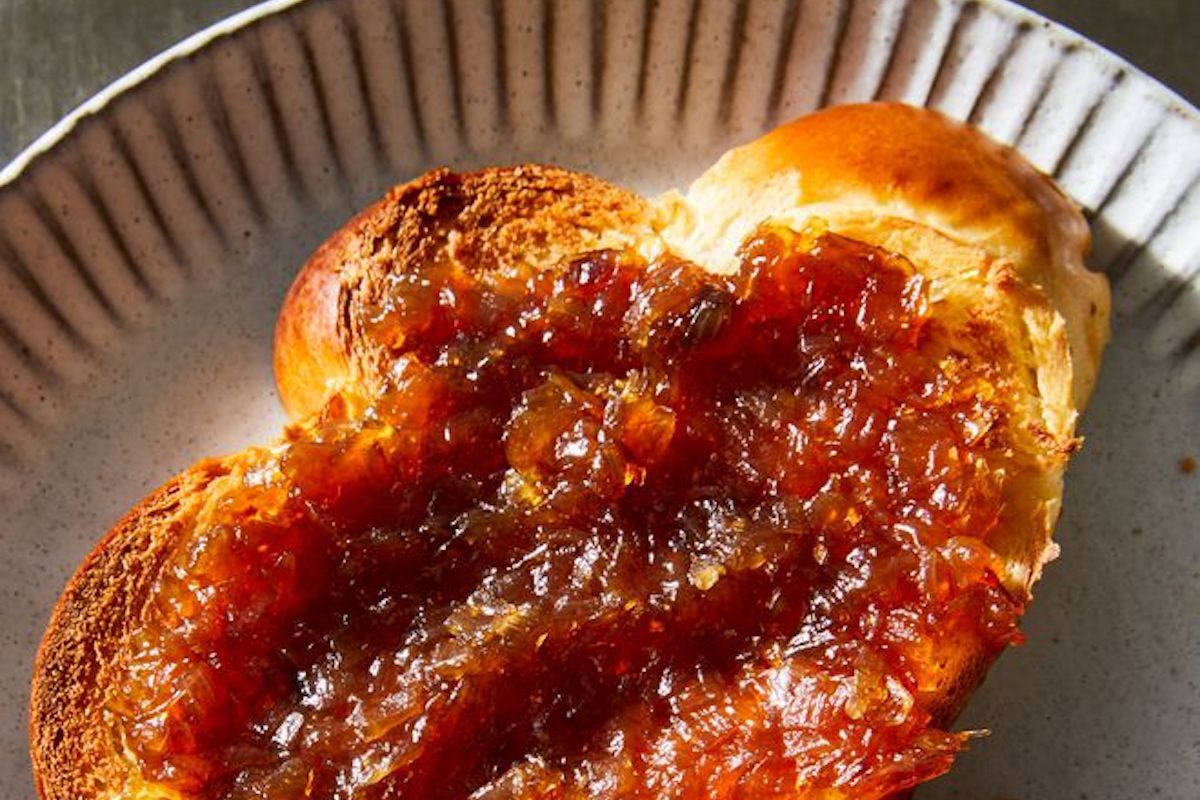Big Little Recipe has the smallest-possible ingredient list and big everything else: flavor, creativity, wow factor. That means five ingredients or fewer — not including water, salt, black pepper, and certain fats (like oil and butter), since we're guessing you have those covered. This week, we're making a savory jam to smear on everything.
* * *
On a good day, jam refers to "a food made by boiling fruit and sugar to a thick consistency." Or on a bad one, "a crowded mass that impedes or blocks movement." This three-ingredient jam is neither.
Yes, we will be boiling. Yes, there will be sugar. But fruit? Not a strawberry or peach or even tomato in sight. Instead: shallots. Lots and lots of shallots.
Sure, jam is best known as a way to stretch summer's bounty, to make fragile berries that would've gone moldy in days last for weeks or months. But just as jam need not be limited to fruits — hi bacon, hello red peppers — it need not be limited to warm weather either.
Come colder, clouder, gustier months, there are plenty of ingredients that would love to be stirred with sugar and simmered, simmered, simmered into oblivion. Especially alliums. Maybe you've already heard of onion jam, on ricotta-dolloped biscuit bites or goat cheese crostini. I like to think of shallot jam as the ultimate onion jam — what an onion dreams of becoming after it falls asleep.
"Shallots are one of the things — a basic prep item in every mise-en-place — that make restaurant food taste different from your food," Anthony Bourdain wrote in "Kitchen Confidential." "You should always have some around for sauces, dressings, and sauté items."
And jam. Score a couple pounds and you're halfway to this high-impact spread that your fridge will be thrilled (chuffed!) to have around. Here's the cheat sheet: Dice shallots and sauté until transparent-ish, like stained glass. Treat to sugar, which will encourage deeper, darker caramelization. Then wake things up with a hefty pour of vinegar.
The last ingredient depends on you — or, more specifically, what you already have around. My vote is for malt vinegar, widely known as the finishing touch on fish-and-chips, but it's a wonder-ingredient in countless other places, too. In this case, it gives shallot jam a roasty, toasty — and, yeah, malty — flavor. Feel free to swap in other vinegars like white wine, red wine, rice, or any of those mixed with balsamic or black.
Once you have shallot jam around, the world is yours, as far as your eyes can see. Try it with:
- Buttered toast
- Triscuits and Gouda
- Pork chops with sautéed peppers
- Crispy sausage and scrambled eggs
- Chopped liver (or liver mousse) toasts
- Penne with butter and Parmesan
- Roast chicken and any vegetables
- Oil and vinegar as a vinaigrette
- Rice-and-beans burrito
- Fettuccine with Greek yogurt
- Quesadilla or grilled cheese
I won't try to hide it — the last one is my favorite. On a bad day, I'll sandwich seedy bread, sharp cheddar, and shallot jam, griddle it until crispy outside, melty inside, then take a bite while it's still too hot. Just like that, the bad day becomes a little better.
***
Recipe: Shallot Jam
Prep time: 15 minutes
Cook time: 50 minutes
Makes: about 1 1/2 cups
Ingredients
- Neutral oil, such as canola or grapeseed
- 2 pounds shallots, peeled and chopped
- 3/4 teaspoon kosher salt
- 1/2 cup granulated sugar
- 6 tablespoons malt vinegar (or another variety), divided
Directions
- Set a wide saucepan over medium heat and add enough oil to thinly coat the bottom. Add the shallots and salt.
- Cover and cook, stirring occasionally, for about 10 minutes, until the shallots have significantly softened and turned a pale, almost-transparent pink.
- Remove the lid and drop the heat to medium-low. Stir in the sugar along with a small splash (about 1 tablespoon) of water. Continue cooking for 30 minutes—uncovered, stirring occasionally, and deglazing with water (about 1 tablespoon at a time) if anything starts to stubbornly stick.
- Stir in 4 tablespoons of the vinegar. Continue cooking for another 10 to 15 minutes, stirring occasionally, until the texture is as jammy as you'd like. At this point, stir in the remaining vinegar, then cut the heat.
- Taste and add more vinegar or salt, if you'd like.
- Let cool, then jar and refrigerate for up to a couple weeks. If the jam becomes too stiff once chilled, you can loosen with a bit of water, vinegar, or both.




Shares